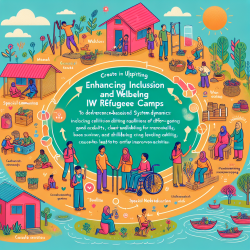Introduction
Inclusion and wellbeing for children with disabilities in refugee camps present unique challenges. The study "Using a community-based system dynamics approach for understanding inclusion and wellbeing: a case study of special needs education in an eastern African refugee camp" provides valuable insights into these challenges and offers recommendations for practitioners aiming to enhance educational inclusion in such complex settings.
Understanding the Context
Refugee camps are complex environments where multiple factors interact dynamically. The study utilized Community-Based System Dynamics (CBSD) to engage key stakeholders, including organization staff, community leaders, and parents, in developing a causal loop diagram. This diagram visualizes the interactions between various components affecting inclusion and wellbeing.
Key Findings
The study identified several themes and feedback loops:
- Value of Inclusion and Wellbeing: Inclusion and community interaction reinforce each other, enhancing wellbeing and reducing discrimination.
- Challenges of Mainstreaming: Mainstream classrooms often lack the resources to support children with disabilities, leading to resistance from parents.
- Organization Services: Services provided by organizations are crucial for meeting basic needs, which is essential for inclusion.
- Funding: Funding is not closely aligned with service demands, making organizations vulnerable to shocks.
Recommendations for Practitioners
Based on the findings, practitioners can consider the following strategies to improve inclusion and wellbeing:
- Expand services to include medical checkups, mental health support, and educational resources.
- Support parental care through training and economic support.
- Increase community interaction through inclusive activities and awareness programs.
- Enhance educational opportunities by hiring specialized teachers and providing scholarships.
Encouraging Further Research
While the study provides valuable insights, further research is needed to explore the unique perspectives of different communities and stakeholders. Practitioners are encouraged to engage in participatory research methods like CBSD to gain a deeper understanding of the complex dynamics in refugee camps.
Conclusion
The study highlights the importance of a nuanced approach to inclusion in refugee camps. By understanding and addressing the dynamic interactions between various factors, practitioners can enhance the wellbeing and inclusion of children with disabilities. To read the original research paper, please follow this link: Using a community-based system dynamics approach for understanding inclusion and wellbeing: a case study of special needs education in an eastern African refugee camp.










